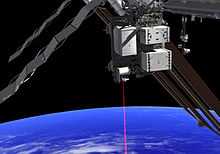OPALS
For other uses, see Opals (disambiguation).

Rendering of OPALS mounted on the ISS
The International Space Station is tracked by a laser during a failed experiment to create an comms link with the OPALS unit designed by NASA JPL. The laser is mounted on the OGS Telescope (Optical Ground Station telescope) at Teide Observatory operated by IAC (Instituto de Astrofísica de Canarias).
OPALS (Optical Payload for Lasercomm Science) is an optical communication in outer space experiment developed at NASA's Jet Propulsion Laboratory for the International Space Station.[1] It is testing the potential for using an optical laser to transmit data, at much higher rates than traditional space-based RF communications, to Earth from space.[1] It was launched to the orbital station aboard a SpaceX Falcon 9 rocket on 18 April 2014, as part of the unpressurized payload cargo of the SpaceX CRS-3 Dragon spacecraft.[2]
The mission has been considered a success as of December 2014. There were two major accomplishments:[3]
- A massive speed increase taking 3.5 seconds to download a video that traditionally would have taken 10 minutes
- Ability to re-acquire tracking after signal was lost due to cloud cover
See also
- Laser space communication
- Free-space optical communication
References
- ↑ 1.0 1.1 NASA's OPALS to Beam Data From Space Via Laser
- ↑ L. Smith, Stephanie; Buck, Joshua; Anderson, Susan (21 April 2014). "JPL Cargo Launched to Space Station". Jet PropulsionLaboratory (NASA). Retrieved 2014-04-22.
- ↑ Landau, Elizabeth (9 December 2014). "OPALS: Light Beams Let Data Rates Soar". Jet Propulsion Laboratory (NASA). Retrieved 18 December 2014.
Further reading
- OPALS Project page at JPL
- David G. Aviv (2006): Laser Space Communications, ARTECH HOUSE. ISBN 1-59693-028-4.
- OPALS details on sensors/cameras, mounting locations, etc.